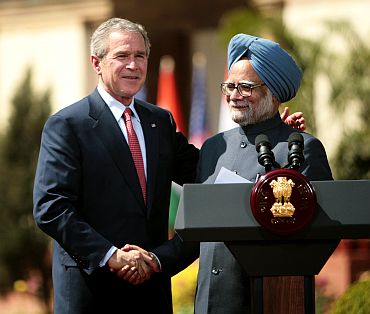Ten years ago a historic, though unexpected, announcement was made in Washington after a meeting between the then US President George Bush and the then Indian Prime Minister Dr Manmohan Singh. It said that the US would “work with friends and allies to adjust international regimes to enable full civil energy cooperation and trade with India”. The deal, which had significant international ramifications, lifted the 30 year American-led moratorium on nuclear trade with India and paved way for transforming relations between the two largest democracies of the world.
While a conference was organized in Washington on the 10th anniversary of the deal, where some of the top leaders who were associated with the process participated in discussions, the anniversary went off largely unnoticed in India. The current dispensation in the Congress perhaps did not wish to credit Dr Singh with the achievement, perhaps his crowning glory as PM, the BJP too did not wish to credit the Congress for the deal in this season of acrimony between the two parties. However, both the BJP and the Congress governments in the past deserved to be patted for the deal. As Dr Sanjay Baru, former media advisor to Dr Singh noted in his book, The Accidental Prime Minister, Dr Singh met Vajpayee on his return from the US and told him that he had only culminated the process which Vajpayee had started as the PM.
One reason for the rather lukewarm response to the 10th anniversary of the deal is the fact that there has not been any significant gain at the ground level as far as setting up of civil nuclear reactors are concerned. In fact the first civil nuclear plant after the deal slated to come up in Haryana is still not even on a take off stage. Land for the plant has been acquired after dealing with opposition from the residents of the area but even the civil engineering work has not started as yet. However, the availability of fuel for the existing nuclear plants has made a major difference. At the time of the deal, India’s nuclear reactors were running out of fuel due to international sanctions. As per official figures, 11 of the country’s 17 nuclear power reactors were operating below capacity and the overall capacity utilization for the country’s nuclear power plants was just about 50 per cent which has now shot up to over 80 per cent after receiving fuel supplies from abroad. The lifting of sanctions has rescued the country’s nuclear program from a serious crisis.
Still, it is the other benefits of the deal that have opened up many vistas not only with the US but with other countries as well who had placed a moratorium on trade with India at the instance of the US after the 1998 tests.
The deal had marked a recognition by the US of the growing role of India in the international stage and its ability to act as a responsible regional and emerging global power. For India it was an end to its mistrust that the US had been “biased” and for the recognition that it was being considered a responsible partner in the process of development across the world.
Experts say that two developments came in the way of the full realization of the deal. One was the failure of the UPA 2 in getting Parliamentary approval for the original civil nuclear liability bill that was drafted in 2010. The opposition demanded redrafting the bill which was subsequently done but with several amendments. The other was the Fukushima disaster in Japan that increased the cost of building nuclear power plants and revived the global anti-nuclear campaign, including in India.
Yet the deal had laid the foundation to build a substantially broader partnership. It is mainly as a fallout of the deal that the US is now India’s largest trade partner in goods and services. It has also emerged as one of the major supplier of defense equipment to India. The majority of US advanced technology exports to India now do not require a license. On the other hand the US imports of high technology from India has more than doubled and exports to India have almost tripled since the deal was signed.
The Obama Administration in its first term, as well as Manmohan Singh government in his second term, did not make much progress and did not seize the opportunity to take it forward. However, there has been some course correction in the last one year and the fillip in the strategic partnership between the two governments led by Obama and Narendra Modi has moved towards a closure on the civil nuclear deal.
#Indo-USnucleardeal
